The Smart Speaker Market is estimated to be valued at USD 18.4 billion in 2025 and is projected to reach USD 136.3 billion by 2035, registering a compound annual growth rate (CAGR) of 22.2% over the forecast period.
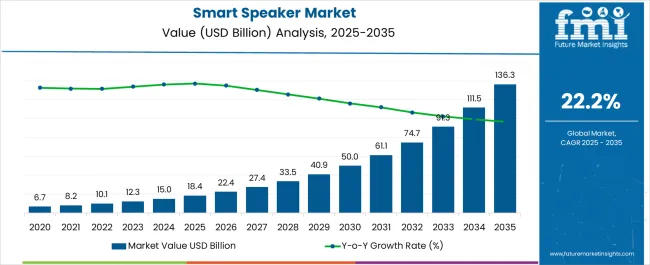
| Metric | Value |
|---|---|
| Smart Speaker Market Estimated Value in (2025 E) | USD 18.4 billion |
| Smart Speaker Market Forecast Value in (2035 F) | USD 136.3 billion |
| Forecast CAGR (2025 to 2035) | 22.2% |
The Smart Speaker market is witnessing robust growth, driven by increasing adoption of connected devices and smart home ecosystems across residential and commercial sectors. Rising consumer demand for voice-controlled interfaces, personalized assistance, and home automation solutions is contributing to market expansion. Integration with artificial intelligence, natural language processing, and cloud-based services is enhancing functionality, enabling seamless control of entertainment, communication, and household operations.
The market is further supported by the proliferation of Internet of Things devices, growing awareness of smart home benefits, and increased investments by technology companies to improve voice recognition accuracy, compatibility, and software capabilities. Premium smart speakers with advanced features are being increasingly adopted in developed markets, while cost-effective solutions are driving penetration in emerging regions.
Security, privacy compliance, and interoperability with multiple platforms are shaping product development and adoption As consumers continue to prioritize convenience, personalized experiences, and integrated smart home solutions, the smart speaker market is expected to sustain long-term growth, supported by continuous innovation and rising digital adoption.
The smart speaker market is segmented by connectivity, price range, and geographic regions. By connectivity, smart speaker market is divided into Wi-Fi Connectivity and Bluetooth Connectivity. In terms of price range, smart speaker market is classified into Premium, Mid-Range, and Low Range. Regionally, the smart speaker industry is classified into North America, Latin America, Western Europe, Eastern Europe, Balkan & Baltic Countries, Russia & Belarus, Central Asia, East Asia, South Asia & Pacific, and the Middle East & Africa.
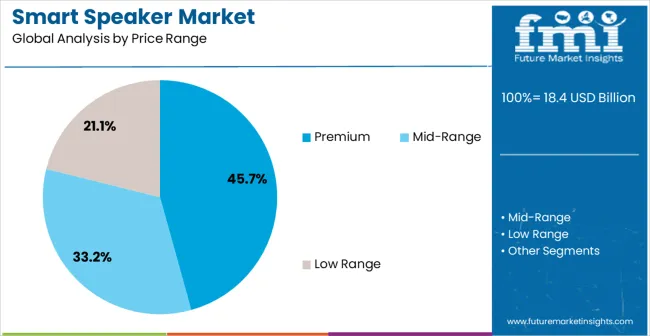
The Wi-Fi connectivity segment is projected to hold 55.3% of the market revenue in 2025, establishing it as the leading connectivity type. This growth is being driven by the reliability, range, and bandwidth offered by Wi-Fi networks, which support seamless streaming, multi-device integration, and consistent voice command responsiveness. Wi-Fi-enabled smart speakers allow users to connect multiple devices and access cloud services for music, smart home controls, and voice assistants without latency issues.
The widespread availability of home and office Wi-Fi networks further accelerates adoption. Enhanced compatibility with IoT platforms, improved security protocols, and integration with AI-driven applications strengthen the segment’s appeal.
Organizations and consumers benefit from scalable solutions that support software updates and multi-room synchronization The growing demand for high-performance smart speakers with uninterrupted connectivity ensures that Wi-Fi remains the preferred choice for connectivity, reinforcing the segment’s leadership and driving its continued market growth in both developed and emerging regions.
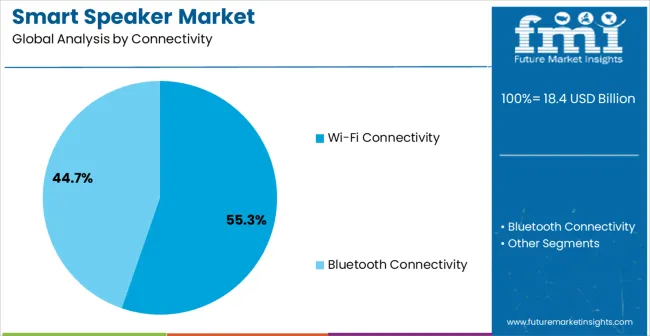
The premium price range segment is expected to account for 45.7% of the market revenue in 2025, making it the leading price category. Its growth is being driven by consumer preference for smart speakers with advanced features such as high-fidelity audio, robust AI integration, multi-device compatibility, and enhanced design aesthetics. Premium devices offer superior performance, extended functionality, and long-term software support, which provide higher value for both residential and commercial users.
The segment benefits from strong brand recognition and trust, with consumers willing to invest in high-quality products that enhance user experience. Growing adoption of smart home ecosystems and multi-device integration further supports demand for premium smart speakers.
Technological innovation, including voice assistant improvements, machine learning personalization, and integration with smart home automation systems, continues to reinforce the appeal of premium devices As consumer expectations for functionality and reliability rise, the premium price range segment is expected to maintain its leading position and drive market growth in the coming years.
Smart Speakers are a wireless device that provides a different kind of connectivity’s to add more function than existing speakers. These additional features are provided for ease of use for customers and to connect. The smart speakers offer features like voice assistant, make the to-do list, set alarms, and provide real time information and much more. A wide range of products are included in smart speakers like boom boxes, LED smart speakers etcetera.
The most trending smart speakers are the ones integrated with Google Home and Amazon Echo which can automate digital tasks along with playing high-quality sound. The smart speakers can work equivalently to the smartphones. Siri and Cortana are also now included in smart speakers.
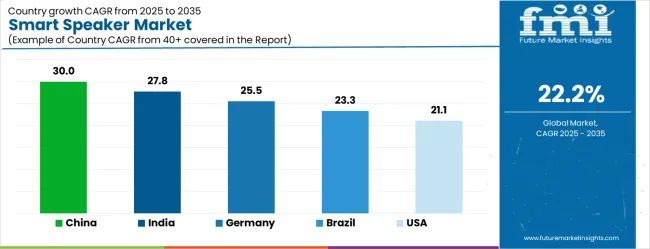
| Country | CAGR |
|---|---|
| China | 30.0% |
| India | 27.8% |
| Germany | 25.5% |
| Brazil | 23.3% |
| USA | 21.1% |
| UK | 18.9% |
| Japan | 16.7% |
The Smart Speaker Market is expected to register a CAGR of 22.2% during the forecast period, exhibiting varied country level momentum. China leads with the highest CAGR of 30.0%, followed by India at 27.8%. Developed markets such as Germany, France, and the UK continue to expand steadily, while the USA is likely to grow at consistent rates. Japan posts the lowest CAGR at 16.7%, yet still underscores a broadly positive trajectory for the global Smart Speaker Market.
In 2024, Germany held a dominant revenue in the Western Europe market and is expected to grow with a CAGR of 25.5%. The USA Smart Speaker Market is estimated to be valued at USD 6.3 billion in 2025 and is anticipated to reach a valuation of USD 6.3 billion by 2035. Sales are projected to rise at a CAGR of 0.0% over the forecast period between 2025 and 2035. While Japan and South Korea markets are estimated to be valued at USD 899.1 million and USD 610.4 million respectively in 2025.
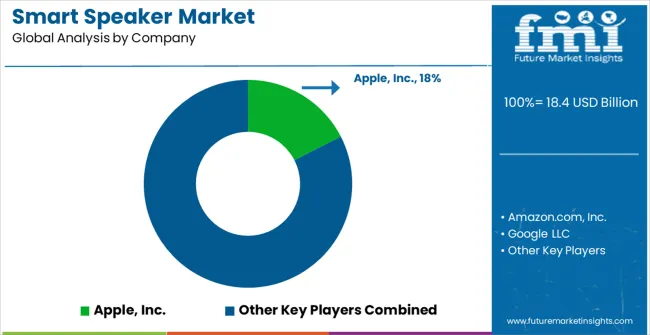
| Item | Value |
|---|---|
| Quantitative Units | USD 18.4 Billion |
| Connectivity | Wi-Fi Connectivity and Bluetooth Connectivity |
| Price Range | Premium, Mid-Range, and Low Range |
| Regions Covered | North America, Europe, Asia-Pacific, Latin America, Middle East & Africa |
| Country Covered | United States, Canada, Germany, France, United Kingdom, China, Japan, India, Brazil, South Africa |
| Key Companies Profiled | Apple, Inc., Amazon.com, Inc., Google LLC, Xiaomi, Bose Corporation, Sonos, Inc., HARMAN International, Sony Corporation, Panasonic Holdings Corporation, ULTIMATE EARS, and Baidu, Inc |
The global smart speaker market is estimated to be valued at USD 18.4 billion in 2025.
The market size for the smart speaker market is projected to reach USD 136.3 billion by 2035.
The smart speaker market is expected to grow at a 22.2% CAGR between 2025 and 2035.
The key product types in smart speaker market are wi-fi connectivity and bluetooth connectivity.
In terms of price range, premium segment to command 45.7% share in the smart speaker market in 2025.






Our Research Products

The "Full Research Suite" delivers actionable market intel, deep dives on markets or technologies, so clients act faster, cut risk, and unlock growth.

The Leaderboard benchmarks and ranks top vendors, classifying them as Established Leaders, Leading Challengers, or Disruptors & Challengers.

Locates where complements amplify value and substitutes erode it, forecasting net impact by horizon

We deliver granular, decision-grade intel: market sizing, 5-year forecasts, pricing, adoption, usage, revenue, and operational KPIs—plus competitor tracking, regulation, and value chains—across 60 countries broadly.

Spot the shifts before they hit your P&L. We track inflection points, adoption curves, pricing moves, and ecosystem plays to show where demand is heading, why it is changing, and what to do next across high-growth markets and disruptive tech

Real-time reads of user behavior. We track shifting priorities, perceptions of today’s and next-gen services, and provider experience, then pace how fast tech moves from trial to adoption, blending buyer, consumer, and channel inputs with social signals (#WhySwitch, #UX).

Partner with our analyst team to build a custom report designed around your business priorities. From analysing market trends to assessing competitors or crafting bespoke datasets, we tailor insights to your needs.
Supplier Intelligence
Discovery & Profiling
Capacity & Footprint
Performance & Risk
Compliance & Governance
Commercial Readiness
Who Supplies Whom
Scorecards & Shortlists
Playbooks & Docs
Category Intelligence
Definition & Scope
Demand & Use Cases
Cost Drivers
Market Structure
Supply Chain Map
Trade & Policy
Operating Norms
Deliverables
Buyer Intelligence
Account Basics
Spend & Scope
Procurement Model
Vendor Requirements
Terms & Policies
Entry Strategy
Pain Points & Triggers
Outputs
Pricing Analysis
Benchmarks
Trends
Should-Cost
Indexation
Landed Cost
Commercial Terms
Deliverables
Brand Analysis
Positioning & Value Prop
Share & Presence
Customer Evidence
Go-to-Market
Digital & Reputation
Compliance & Trust
KPIs & Gaps
Outputs
Full Research Suite comprises of:
Market outlook & trends analysis
Interviews & case studies
Strategic recommendations
Vendor profiles & capabilities analysis
5-year forecasts
8 regions and 60+ country-level data splits
Market segment data splits
12 months of continuous data updates
DELIVERED AS:
PDF EXCEL ONLINE
Smart Meeting Pod Market Size and Share Forecast Outlook 2025 to 2035
Smart Electrogastrogram Recorder Market Size and Share Forecast Outlook 2025 to 2035
Smart Aerial Work Robots Market Size and Share Forecast Outlook 2025 to 2035
Smart Bladder Scanner Market Size and Share Forecast Outlook 2025 to 2035
Smart School Bus Platform Market Size and Share Forecast Outlook 2025 to 2035
Smart Home Wireless Smoke Detector Market Size and Share Forecast Outlook 2025 to 2035
Smart Bus Platform Market Size and Share Forecast Outlook 2025 to 2035
Smart Vision Processing Chips Market Size and Share Forecast Outlook 2025 to 2035
Smart Touch Screen Scale Market Size and Share Forecast Outlook 2025 to 2035
Smart Magnetic Drive Conveyor System Market Size and Share Forecast Outlook 2025 to 2035
Smart Wheelchair market Size and Share Forecast Outlook 2025 to 2035
Smart Mining Technologies Market Size and Share Forecast Outlook 2025 to 2035
Smart Parking Market Size and Share Forecast Outlook 2025 to 2035
Smart Digital Valve Positioner Market Forecast and Outlook 2025 to 2035
Smart Card IC Market Size and Share Forecast Outlook 2025 to 2035
Smart-Tag Inlay Inserters Market Analysis - Size and Share Forecast Outlook 2025 to 2035
Smart TV Market Forecast and Outlook 2025 to 2035
Smart/AI Toy Market Size and Share Forecast Outlook 2025 to 2035
Smart Locks Market Size and Share Forecast Outlook 2025 to 2035
Smart Sprinkler Controller Market Size and Share Forecast Outlook 2025 to 2035

Thank you!
You will receive an email from our Business Development Manager. Please be sure to check your SPAM/JUNK folder too.
Chat With
MaRIA